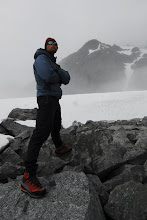On May 29th, 2012 Dan Hilden and I stuffed duffel bags of gear and food into a red twin otter and buckled up for the wild flight that is the approach to the Alaska Range (for most people). Our first intent was to climb Denali via the West Buttress for acclimitization purposes, but also to begin the learning process of the intricicies of high altitude climbing. Before this trip, Dan had pegged 15,000 feet in Peru and I had only attained a measly 13,000 in the Sierras. We had no clue what to expect, but hoped we would have the time to attempt the Cassin Ridge after we followed the standard path to the top.
We spent the best weather of our trip hauling loads up to Denali's 14,000 foot basecamp. As we were doing so, two teams were climbing the Cassin. Everything seemed to be falling into place and psyche was high.
Pulling sleds full of gear and food is hard! But beautiful...
A day after arriving at basecamp I cramponed up to 15,500 feet, reveling in the chaotic scene of icefalls, endless white, and the sound of my own steady breathing. The following day, Dan and I peddeled up the West Ridge to 16, 700 feet. The next mission took us to 17,000 feet, where we sat for only minutes in cold, chapping wind. Some days later we used a few good hours of weather to climb a 2,000 foot ice face above basecamp. We topped out on a ridge at 16,000 feet in extremely windy and snowy weather. Fortunetely, we only had to find the fixed lines that were half a mile down the ridge to gain salvation from the storm. Still, those moments showed me how serious it can get when the weather hits the fan.
Basecamp at 14K
And then it really started snowing. A lot. More than I have ever seen, but then again, I haven't really seen much. We dug and dug, unleashing our tent from the suffocating snow that would smother it again only minutes after its liberation. Conditions morphed from squeaky cramponing on firm snow, to thigh deep slogging through oceans of unstable powder. Four people died in an avalanche on a well traveled slope. More were injured in similar accidents, and one skiier was swept away in the Messner Coulior as we watched him make turns down the steep chute. He lived, but shouldn't have and it took a day to get the image of him being overtaken by snow out of my head.
Dan passing a storm day perfecting the alpine pancake
The days passed and our window of time became shorter and shorter. Conditions had not improved and no one was climbing up the mountain by any route other than the trenched out West Buttress. All of the sudden we realized we might not even make the top on this trip. That was a disconcerting thought, but seemed a clear reality, especially after our first summit attempt ended high on the mountain in weather too cold for my toes and Dan's face. Even the summits of our dreams aren't worth losing toes and fingers.
Finally, with only days left before flying out of the range, we left the 14,000 foot camp in warm (hot!) sunshine, hoping beyond hope that we would stand on top. We passed our high point and slogged on to higher elevations. Once above 19,000 feet, the slog intensified. Obviously, the climbing was not technical in nature, but my mind still had to be strong so that I could keep putting one foot in front of the other. We didn't rush, instead relying on a constant, steady pace. Finally, we could go no further and I found myself taking in one of the most beautiful views I have ever seen. Lifetimes of mountains studded the landscape, with twisting rivers and the deep green of forest beyond. Clouds floated below us and I had a real sense of being high in the sky. Our descent went smoothly and soon we were back at camp having made the summit in 11.5 hours round trip from 14K.
Descending on summit day
About to descend the fixed lines on summit day
With only a couple of days left before flying out, and conditions that we didn't feel were safe for big, commiting routes, our trip was done. The Cassin would have to wait.
Although I was dissapointed to spend so much time just trying to hike to the top, I learned so much about climbing at altitude. Of course, thin air makes everything harder and more dangerous, but it also brings an intense focus and immersion in the moment. The sense of accomplishment is stronger and the beautiful details of a climb stand out even more. Dan and I were excited to see that our bodies and minds did well up high. We hope to take what we have learned back to Denali, but also beyond, to the other high mountains of the world.
Below are a few more shots. All photos in this post were taken by
Dan Hilden.
Dan on an awesome ice pitch during an acclimitization mission
Another day digging the tent out...
Cumbre!!
Just below the summit
Waiting to fly out
Denali!! See ya next season...





















































